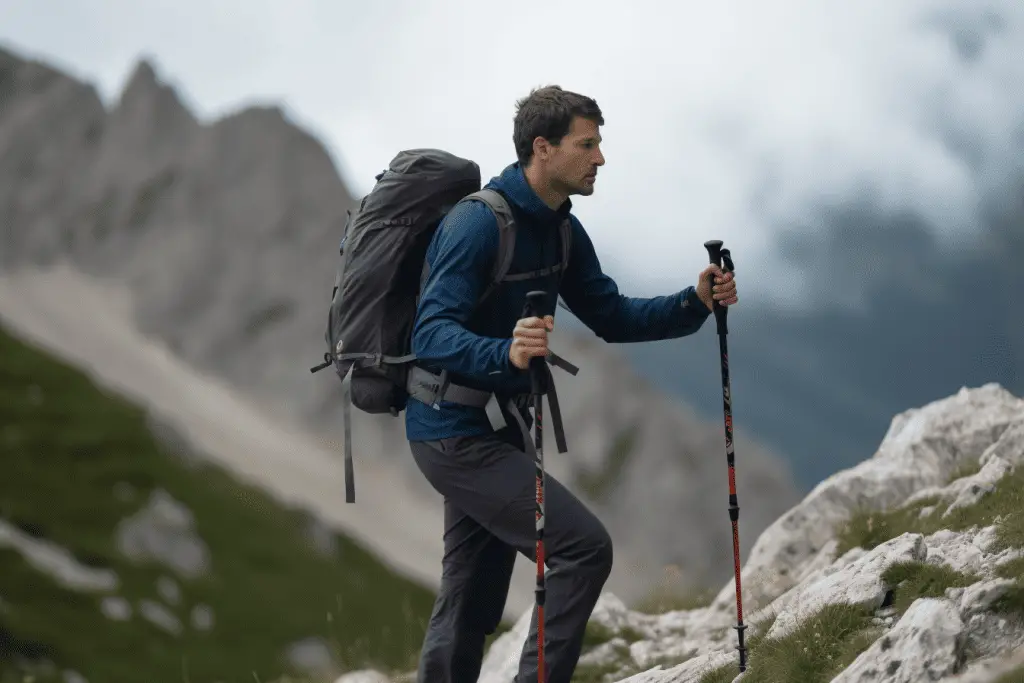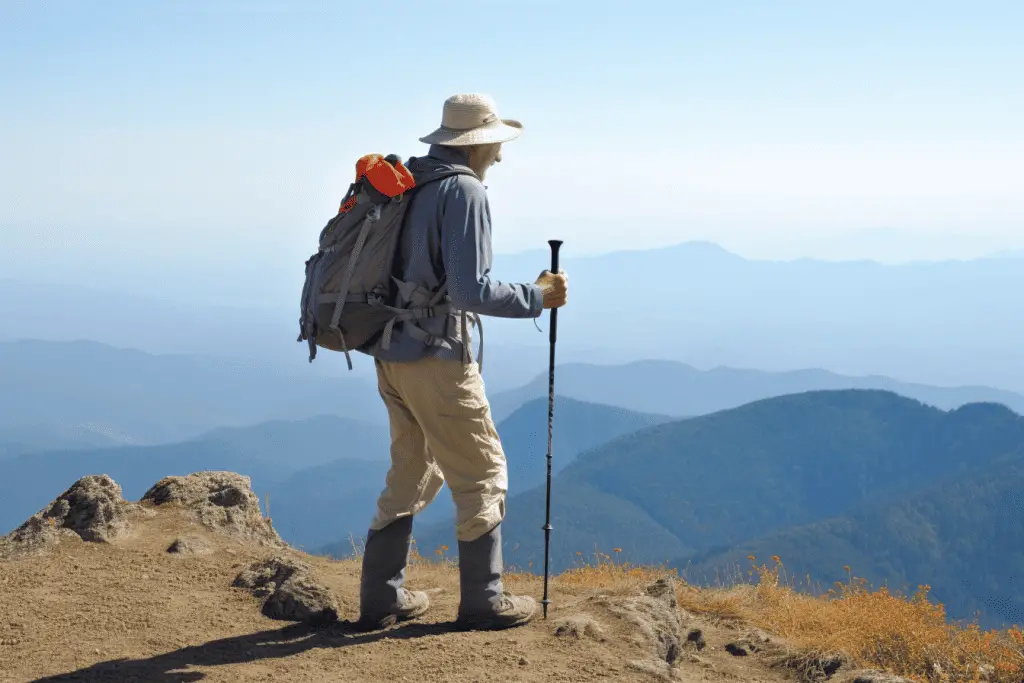There is no doubt that trekking poles and hiking staffs can make hiking and backpacking both easier and safer. But which is better? In this post, we’ll tackle the debate between trekking poles vs hiking staff to see what’s better.
Before we dive into the nitty-gritty of our hiking gear comparison, let’s first understand what we’re dealing with. In one corner, we have trekking poles, often sold in pairs and used together. These are typically lightweight, adjustable, and designed for balance and rhythm as you cover a variety of terrains.

On the other hand, we have the hiking staff, also known as a hiking stick or walking stick. This is usually a single pole that’s taller than a trekking pole. It’s a trusty friend for hikers who prefer a third ‘leg’ for stability, particularly on uneven surfaces or during steep descents.
Now, both trekking poles and hiking staffs can help you maintain balance, reduce strain on your joints, and increase your hiking speed. But the right choice for you depends on several factors, like your personal preference, fitness level, and the type of trails you’ll be trekking. So let’s dive a little deeper into the unique benefits and downsides of each. Buckle up – it’s time to choose your trail companion!
Exploring the Design Blueprint: Trekking Poles vs Hiking Staffs
So, what makes a trekking pole different from a hiking staff? Well, quite a few things actually. Let’s get to know them a bit better.
Trekking poles, often used in pairs, are generally shorter, lighter, and adjustable in length. They’re typically made of lightweight materials like aluminum or carbon fiber to make your trek as easy as possible. Most designs include features like shock absorbers and interchangeable tips to adapt to different terrains. A common feature is the telescoping or foldable design, which allows the poles to be collapsed when not in use, making them highly portable.
Now, let’s talk about hiking staffs. They’re taller – about shoulder or head height – and are usually used singly. Some folks prefer them for the stability they provide, especially when navigating tricky terrain. Traditional hiking staffs are often made of wood, but modern designs can also be found in lightweight materials like aluminum. Hiking staffs usually come with a wrist strap, and may include features like a built-in compass or even a monopod for the photography enthusiasts out there.
In a nutshell, the primary differences lie in their structure and intended use. Trekking poles are all about providing rhythm and balance, while hiking staffs focus more on stability and support. Your preference might come down to the type of hiking you do, or even how you feel when using one versus the other.
Embracing the Benefits: Why Choose Trekking Poles?
Now, let’s get into why you might want to side with trekking poles for your next outdoor adventure. These handy companions have quite a few benefits up their sleeves!
First off, trekking poles are all about balance and rhythm. When you’re taking on rocky terrains, crossing streams, or tackling slippery slopes, having a pair of trekking poles can significantly improve your stability. They act as an extra set of legs, giving you a better footing and reducing the risk of falls or injuries.
Secondly, they can take a lot of stress off your knees and legs, especially during downhill hikes. Studies show that trekking poles can reduce compressive force on the knees by up to 25%. So if you’ve had knee trouble or just want to give your joints a bit of a break, trekking poles might be your best bet.

Thirdly, hiking with hiking poles can help you establish and maintain a consistent pace, which can be a real game-changer on longer hikes. The rhythm created by the poles can help conserve your energy and increase your speed, making your journey smoother and more efficient.
Lastly, but certainly, not least, trekking poles aren’t just for walking. They can serve as a multi-purpose tool in many situations – think of pitching a tent, testing the depth of a stream, or even warding off wildlife.
So, whether you’re a seasoned hiker or a beginner starting your journey, trekking poles could be a valuable addition to your hiking gear. But remember, they’re not the only option out there. Let’s not forget our sturdy friend, the hiking staff!
Walking Tall: The Benefits of a Hiking Staff
Switching gears, let’s take a look at why a hiking staff could be the perfect trail companion for you. Despite being a bit more traditional, this trusty ‘third leg’ has quite a few advantages of its own.
The first thing that springs to mind is stability. A hiking staff offers strong support and balance, particularly on uneven or challenging terrains. If you’re venturing over loose rocks, steep inclines, or tricky stream crossings, a hiking staff can help you navigate these obstacles with ease.
Next up, we have the advantage of weight distribution. Leaning on a hiking staff can take some of the load off your lower body and redistribute it across your upper body. This can be particularly beneficial when you’re carrying a heavy backpack.

A hiking staff is also a great tool for testing surfaces. Before stepping on uncertain ground or crossing a body of water, you can use your staff to test its firmness or depth. It’s always better to be safe than sorry, right?
And let’s not forget about the advantage of simplicity. A hiking staff is generally straightforward to use and requires less coordination compared to using a pair of trekking poles. It’s just you and your staff, tackling the trail together. Not to mention it leaves you with a free hand!
Finally, hiking staffs often come with some pretty cool features. Some designs include built-in compasses, camera mounts, or even hidden flasks for a sip of water (or something stronger) on the go!
All in all, if you’re after simplicity, stability, and a touch of old-school charm, a hiking staff might be the perfect companion for your next hiking adventure. But remember, the choice between a hiking staff and trekking poles will ultimately depend on your personal preference and hiking needs.
Navigating the Decision: How Terrain and Distance Influence Your Choice
Terrain and distance are like the cheese and wine of hiking – they’ve got to pair well with your gear for a memorable adventure. These two factors can greatly influence whether a trekking pole or a hiking staff is the right fit for your journey.
Starting with terrain, if your trail is rocky, steep, or involves river crossings, using a pair of trekking poles can provide excellent balance and stability. They allow you to distribute your weight evenly and can help prevent slips or falls. On the other hand, if you’re navigating relatively flat trails, a hiking staff may be all you need to support you and your pack.
Moving on to distance, the length of your hike can also influence your decision. If you’re planning a long, strenuous trek, trekking poles can help maintain a steady rhythm, which in turn boosts your efficiency and speed. They can also take some of the strain off your lower body, reducing fatigue over time. For shorter, more casual hikes, a hiking staff could be more than enough to provide stability and support.
Cost and Durability of Trekking Poles vs Hiking Staffs
Okay, let’s talk about the elephant in the room – your budget. Cost and durability are often key considerations when choosing between a trekking pole and a hiking staff. After all, you want something that’s going to last without breaking the bank, right?
How Much Do Trekking Poles Cost?
Trekking poles can range in price quite a bit, depending on their features and the materials used. Basic models can be pretty affordable, while high-end poles made from lightweight, durable materials like carbon fiber can cost a pretty penny. But remember, these often come with advanced features like shock absorption, adjustable lengths, and interchangeable tips for different terrains, which can make them a good investment for regular hikers.
How Much Do Hiking Staffs Cost?
On the flip side, hiking staffs tend to be less expensive. Traditional wooden staffs are generally the cheapest, while lightweight aluminum models can be a bit more pricey. They may lack some of the advanced features of high-end trekking poles, but they’re sturdy, reliable, and can still offer a good lifespan if cared for properly.
How Long Do Trekking Poles and Hiking Staffs Last?
In terms of durability, both trekking poles and hiking staffs can stand the test of time with the right care. However, bear in mind that lightweight materials, while great for portability, can be more prone to damage under harsh conditions.
Ultimately, your decision should factor in how often you hike and the types of trails you frequent. If you’re an occasional hiker sticking to easy trails, a budget-friendly hiking staff could be a great pick. But for the regular, ambitious hiker taking on varied terrains, investing in a durable, feature-rich pair of trekking poles could be worth every penny. So, think about your hiking habits, your budget, and choose wisely!
Making Your Choice: The Final Verdict on Trekking Poles vs Hiking Staffs
As we wrap up our deep-dive into the world of trekking poles vs hiking staffs, remember that the perfect trail companion is as unique as your own hiking journey. It’s all about balance – between your personal comfort, the nature of the trail, your physical condition, and yes, your budget too.
Whether you’re Team Trekking Pole, favoring their rhythm and knee-friendly benefits, or a Hiking Staff devotee, drawn to their simplicity and stability, the important thing is you’re getting out there and embracing the great outdoors. At the end of the day, your choice is a personal one. Equip yourself with the knowledge, weigh your options, and you’re sure to make the best decision for your next adventure.
